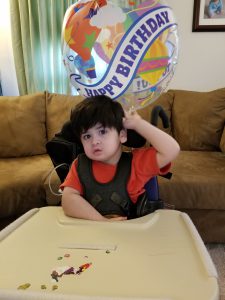
About a month ago, Joey turned four. Four! The big two plus two equals four. No longer the three-nager but not quite ready for kindergarten. What does it mean to be four?
Chip Wood, author of Yardsticks, writes “Four year olds tend to be ready for everything. They are explorers and adventurers who are soaking up the world of knowledge with incredible speed.” Although Joey is not your typical four-year-old, he still shares many characteristics with his typically developing peers. I find it helpful to remember children’s age related developmental stages.
Wood notes that four-year-olds are friendly, talkative, and love being with friends although they are not quite ready to work with a friend to solve a problem. They still need adults to help them express their wants and needs instead of just reacting physically. They love having jobs and responsibilities at school and at home, love being read to, and in experimenting with language. Four-year-olds tend to love dinosaurs, transportation vehicles/things that go, and learning about themselves through all about me units.
Yup, all of that sounds like Joey. He is certainly ready to engage with us, and to talk to us in any way he can, and he certainly is working with us at communicating what he wants. Joey may be more skilled than most four-year olds at this, as he’s made considerable progress in communicating instead of crying to show us what he wants since he started using his eye gaze device over a year ago. He does love being read to and exploring new words on his device. And loving dinosaurs and things that go? Check and check.
Wood also notes that four-year olds tend to have short attention spans, learn best through moving their large muscles, exploring, and pretending. To help four-year olds learn, Wood suggests providing them with as many hands-on learning opportunities as possible, and allowing them to explore with magnets, pulleys, cubes, scoops, and measuring cups. Model problem solving, self-regulation, and expected behavior as much as possible, and allow for as much movement with learning as possible.
For me, this is such a great reminder of Joey’s typically developing abilities despite his limitations. It is also a reminder that all four-year olds need to move to learn, and that Joey isn’t any different. I need to find ways to incorporate more of what I do outside of his chair, so he can be more active in exploring moving during our learning. I can also do more modeling of self-regulation. Although I model language for Joey frequently, I have not modeled any self-calming or problem-solving strategies. In the classroom I found this much easier to do than now, when I’m working with Joey one on one. But I certainly can find ways to act out getting upset about something and then using words to ask for what I want, or to help myself calm down.
I know that four is going to be a great year for him! Happy Birthday Joey!
Wood, C. (2017). Yardsticks: Children in the classroom ages 4-14. Third Edition. Center for Responsive Schools, Turner, MA. Pages 47-55.


